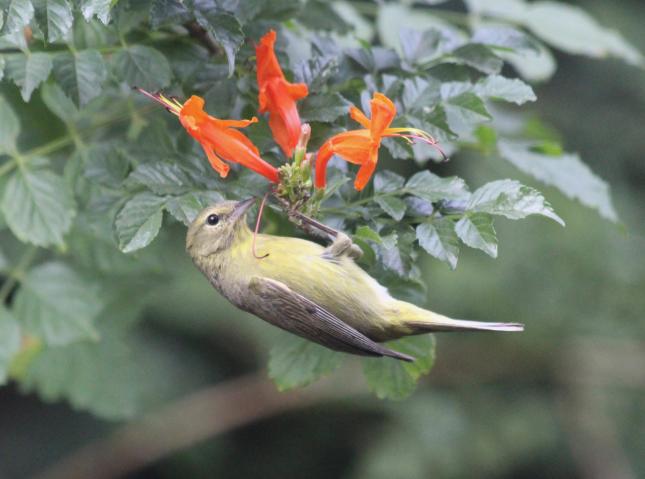Orange Crowned Warbler
Orange-crowned Warblers aren’t the most dazzling birds in their family, but they’re a useful one to learn. These grayish to olive-green birds vary in color geographically and have few bold markings. There’s rarely any sign of an orange crown, which is usually only visible when the bird is excited and raises its head feathers. They might have you scratching your head until you recognize their slim shape, sharply pointed bill, and warmer yellow under the tail. These busy birds forage low in shrubs, and are one of the few warblers that's more common in the West than the East.

Cool Facts
- The Orange-crowned Warbler is divided into four subspecies that differ in plumage color, size, and molt patterns. The one named celata is found in Alaska and across Canada, and it is the dullest and grayest. The Pacific Coast form, lutescens, is the brightest yellow. Found throughout the Rocky Mountains and Great Basin, orestera is intermediate in appearance. The form sordida is the darkest green and is found only on the Channel Islands and locally along the coast of southern California and northern Baja California.
- Most Orange-crowned Warblers nest on the ground, possibly to avoid nest-robbing birds. One exception is the sordida or “dusky” subspecies that breeds on California’s Channel Islands. With fewer avian predators to worry about, it nests in tall shrubs and trees away from most snakes and mammals—except on Santa Cruz Island, where the endemic Island Scrub-Jay is a threat.
- The male Orange-crowned Warbler’s song is far more variable than that of other wood warblers—so much so that the males can be told apart by their distinctive song patterns. Breeding males often form “song neighborhoods,” where two to six birds in adjacent territories learn and mimic each other’s songs. These “neighborhood” songs can persist for years.
- Orange-crowned Warblers begin their spring migration earlier, stay later on the breeding grounds, and winter farther north than most other warblers. Food rather than day length seems to drive their migratory calendar, as they begin to leave the breeding grounds when cold or drought limit supplies of insect prey.
- The oldest known Orange-crowned warbler was a male, and at least 8 years, 7 months old when he was recaptured and rereleased during banding operations in California.
Orange-crowned warblers can be found year-round in Ventura county, but can be seen in larger numbers during spring and fall migration.
Orange-crowned warblers can come to your suet feeders, mealworm feeders or you may see them foraging for insects off of your plants.
Most of the information contained in this article is from Cornell Lab's All About Birds.

